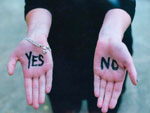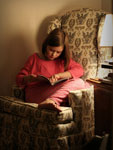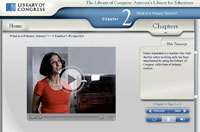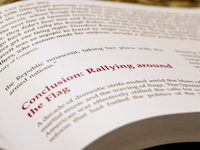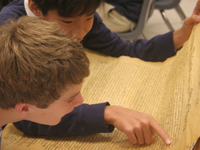Alice: One of the reasons why we chose K-3 is because we feel that they are a very underserved group. While we live in the suburbs of Washington and have access to lots of institutions that offer professional development, most of these programs are geared towards secondary teachers. And so the K-3 people are required to teach history in their classrooms because of our state standards and requirements, yet they are generalists, they do not have the background knowledge, and they really don't have access to targeted professional development.
This is a group that had extraordinary enthusiasm for what we were doing because they sense that need in their classrooms.
Cynthia: They were very easily recruited, and then turned around and quickly recruited other teachers. So, this is a group that had extraordinary enthusiasm for what we were doing because they sense that need in their classrooms.
Alice: We did have elementary teachers in our previous grants, and while it was, again, the focus was content, we felt that some of our elementary teachers were intimidated by the content knowledge base of our secondary teachers, who could at times be very intense and passionate about history. And so we decided that as an underserved group, it would be easier to really address their background needs and get them comfortable with the history content, to give them the confidence to be able to do some interesting, engaging, creative ways of instruction.
Cynthia: They read three books during our one-year TAH program, but over the course of the years, they've come back to me with volumes and volumes that they've read.
Alice: And then that enthusiasm that was developed comes across in their instruction, runs over into the kids.
And another unintended consequence of this also was the kids going home and telling their parents. Because at the primary level, parents are always asking, "What did you do in school today? What did you learn?"
And another unintended consequence of this also was the kids going home and telling their parents. Because at the primary level, parents are always asking, "What did you do in school today? What did you learn?" And the kids were just bubbling about what had happened in school and what they had done in history class and learned about it. And with our large ELL population, these are parents that do not have a background in American history, and so the parents are also learning from the kids. And of course, that motivates the kids more because their parents are interested. So, it was a very nice unintended consequence.
Cynthia: A lot of our K-3 classrooms are covered with little stickies because wherever, you know, Eleanor Roosevelt is up in the classroom, kids come back with little stickies of what they've Googled about Eleanor Roosevelt and stuck up on the wall. So, there's evidence everywhere of the enthusiasm and the sort of taking root of history that's happening outside of the classroom. And they are pulling their parents along with it, too, according—at least anecdotally—to our teachers.
Cynthia: We have a one-week Summer Institute, and it has to do a lot with our emphasis on working with teachers to emphasize object learning, to emphasize the use of primary documents or photographs or, you know, anything that small children can really get their hands on. Using time and place, location, and—
Alice: Biographies.
Cynthia: And biographies.
We spend one day at Gunston Hall learning about the Constitution, learning about a lot of American historical figures, and as heroes and what their heroic attributes are along with their humanity. And then we spend a day at various Smithsonian Museums. We've had a wonderful experience at the Postal Museum, at the National Museum of American History, at the Portrait Gallery, at American Art.
And then the last day we have spent at Mount Vernon, primarily focused on George Washington. And that has turned into a really special day because there's obviously a large number of wonderful historical scholars on the subject of Washington. But so many now have become very comfortable in using place, you know, using the mansion and the grounds to talk about Washington as a farmer and as a recorder and as a hero during the war, a leader that walked away from power.
Scholarship in one massive lesson can be brought to bear on math, on language arts, on social studies . . .
So we've got scholarly discussions going on after tours. And then, finally, we've brought in some experts in primary education that take those George Washington lessons and bring teachers down around the floor creating maps on, you know, a shower curtain, and doing mathematical exercises coming out of the lessons of where Washington's armies were, etc., etc. So, really, cross-curricular work in showing how that scholarship in one massive lesson can be brought to bear on math, on language arts, on social studies, and so on and so forth. And then we follow that up during the school year with two full-day academic experiences like that. One of them we do at the National Museum of American Indian because they study the various Native cultures.
And another one where we work with them full-day in one of our high schools in their theater department with their theater coaches and sometimes their kids, to teach the teachers how to become those, to become Martha Washington instead of talking about Martha Washington, so that every day is kind of an exciting theatrical production in a first-grade classroom. And then there are two book talks, which happen after school, a three-hour period, where they sit down with a scholar and discuss the books that they've read.
Alice: So, the content and the teaching of historical thinking is done through really four different strands. Biographies, because so many of them are emphasized in our state-required curriculum. Object-based learning, because many of these primary kids we recognize can't read, but yet visually are able to think historically. Teaching history through time and place, and we recognize that that whole idea of time and sequencing and chronological order is probably the hardest thing to teach primary kids, but using it in a way that makes it engaging and motivating. And then the fourth one is to teach history through art, music, and drama. And that's the content that we base this whole module for the K-3 folks on.
Cynthia: We've been really happy with the fact that people who start this program finish it. We have very little absenteeism, and so, in other words, the load is not too heavy, but certainly they walk away with a lot of materials and a lot of ideas and a lot of scholarship.
Alice: And the expectation is for teachers to attend, obviously, all of these sessions and participate, participate in our rigorous evaluation program, which we have, as well as to produce a lesson plan using some of the content that they have learned and a primary source. These lesson plans are then posted on our local Blackboard site for our teachers to share, and so they can then see the implementation of it.
Cynthia: And I think it's important to note that on our pre- and post-evaluations of teachers and kids in this program, we saw by far the greatest gain amongst our K-3 teachers because, admittedly, they didn't have that background, so they tend to learn very quickly.
It's that pedagogy and the historical thinking, "Well, if they can do that in second grade, I can do that in third grade," or "I can do that in fourth grade."
Alice: Within a school, it's, even though other teachers may be—other grade levels may be teaching different content, it's that pedagogy and the historical thinking, "Well, if they can do that in second grade, I can do that in third grade," or "I can do that in fourth grade." And the kids are starting to demand it too because the kids are starting to say, "Well, last year we did such and such," and so we're starting to see that ripple effect as well, which is really neat to see. And the confidence level of the teachers, because they can go beyond what our state document requires, which is pretty detailed in terms of content.
And really, to me, putting the story back in history, and we all know that given the story and the relevance of those stories, it can be much more motivating and engaging for kids.
Cynthia: And I have to say to be straight up, they desperately need the resources in those classrooms. There are very few of them. Every time I was out with teachers, they were spending every dime they'd ever earned buying things for their classroom. So, if we were able to give them some of the tools, the objects, recreate colonial games and those kinds of things, teach the letters with a colonial doll in the way that they used to teach them in colonial times. That's something that's deeply appreciated by them, and I think it's a little bit of a give-back to them to give them those tools that they really need.
Alice: So, we gave, as part of the grant, each of these primary teachers received an artifact box with a lot of these objects in it that they would then take back to their classroom.
Frankly kids prefer non-fiction. They want to know it's a true story. They want to know history.
Cynthia: Primary teachers really appreciate the information to go back to their schools to say, "I'm not taking time away from 'No Child Left Behind,' a subject. I am in fact using history to teach literacy. I am teaching reading through non-fiction." And frankly kids prefer non-fiction. They want to know it's a true story. They want to know history.
I didn't have to recruit at all K-3. They recruited each other. They had set up after school specials to pull people in and say, "This is what I got. This is what I did. This is why I loved it." And they were always full, those groups.
Cynthia: One of the most amazing lessons was one that absolutely defies description. A young teacher in the program who was an English as a Second Language teacher, but she was working within a large classroom. So, it was close to 30 second graders, and there was maybe a third of those where English was not their first language. And she was working with small children, young children, and she was working with four important documents. So, she had a relatively large version of the Constitution, next to the Declaration of Independence, next to the Gettysburg Address, next to Martin Luther King's "I Have a Dream" speech. And the kids together found language that was consistent across all four documents and highlighted and colored and circled and whatnot, and talked about what those concepts were, and did those concepts mean the same thing at the founding of the nation as they did in the time of Martin Luther King? She then put a couple of those at least, on audio, so an actor was reading the Gettysburg address, and the kids hands would shoot up when they'd hear that familiar vocabulary. And then she did the Martin Luther King speech similarly, although in his words this time.
It was utterly inspiring. I think many people would think it was too much to do in an 11th-grade classroom.
She had visual pieces where she had portraiture from the Portrait Gallery that she had cut up into pieces so that the kids had to put those back together as a puzzle. And then they came back together again and discussed what those documents meant, what that language meant, and critical thinking exercises ensued about change over time and what this nation really stands for and has tried to stand for over time. So, it was utterly inspiring. I think many people would think it was too much to do in an 11th-grade classroom. Never true, but really well accomplished in a second-grade classroom.
